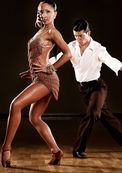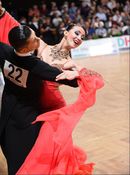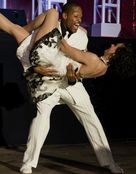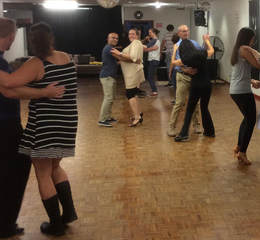|
480C Glen Huntly Road Elsternwick
|
The Destine Dance proficiency coursesLearn to Dance in 6 Weeks!
|
|
Each course:
|
|
The courses
There are four courses you can do. You are encouraged to do all of them so that you can experience a diversity of styles and be certain you have found the type of dance you like. However, you may do whichever course you like and in any order you like.
If you wish, then you may do 2 at one time. However, you should ensure that this will leave time for practice outside of class.
The details of the styles taught in each course are given below. Scroll down further to learn when the next courses are running and what the cost will be.
If you wish, then you may do 2 at one time. However, you should ensure that this will leave time for practice outside of class.
The details of the styles taught in each course are given below. Scroll down further to learn when the next courses are running and what the cost will be.

Street Latin
This course will cover salsa and tango - two of quintessential and classic dances from the street Latin group. The salsa captures the fun and vibrancy you would expect from a dance that originated in the Caribbean and brings together the rhythm of Africa and the style and sensuality we associate with the Latin culture. The tango captures the suaveness also associated with Latin culture and remains true to the romance of the error from which it came. By learning these two styles, you will have an appreciation for all that street Latin can offer and be ready to learn more while being able to enjoy these two classic dances socially.
This course will cover salsa and tango - two of quintessential and classic dances from the street Latin group. The salsa captures the fun and vibrancy you would expect from a dance that originated in the Caribbean and brings together the rhythm of Africa and the style and sensuality we associate with the Latin culture. The tango captures the suaveness also associated with Latin culture and remains true to the romance of the error from which it came. By learning these two styles, you will have an appreciation for all that street Latin can offer and be ready to learn more while being able to enjoy these two classic dances socially.

Latin American
This course aligns more with the international standard Latin dances that you might have seen on TV. The dances taught are the Jive and the Cha Cha. The fame of the Cha Cha is evident by the fact the almost everyone knows it by name. It is a fun dance danced to Latin music so it brings a mix of sophistication, vivacity and sultriness. Jive puts the American into Latin American. Evolving out of Lindy hop (which Originating from Harlem in the 1930s), jive offers a dance that expresses much of music that is popular today and heavily influenced by African American musical patterns. With its sense of inhibition and energy, jive proves to be one of the more high energy dances. At the end of this course you will have learned classic and usable dances that demand higher technique. This will give you a great balance of attributes for taking your dance further.
This course aligns more with the international standard Latin dances that you might have seen on TV. The dances taught are the Jive and the Cha Cha. The fame of the Cha Cha is evident by the fact the almost everyone knows it by name. It is a fun dance danced to Latin music so it brings a mix of sophistication, vivacity and sultriness. Jive puts the American into Latin American. Evolving out of Lindy hop (which Originating from Harlem in the 1930s), jive offers a dance that expresses much of music that is popular today and heavily influenced by African American musical patterns. With its sense of inhibition and energy, jive proves to be one of the more high energy dances. At the end of this course you will have learned classic and usable dances that demand higher technique. This will give you a great balance of attributes for taking your dance further.

Standard (Ballroom)
Much of partner dancing today can be traced back to the ballrooms of Europe over 200 years ago. This is what many think of when they think of ballroom dancing. However, the standardised ballroom dances we have today have evolved and are more modern than you might think. They still manage to keep the same sensibility of the original dances. The two dances we teach in this style are the waltz and the quickstep. The waltz, which can trace its origins back to the times of Jane Austen, is a close dance that offers that sense of lilting buoyancy on the dance floor and a strong connection with your dance partner. The quickstep is a child of the 1920s. As such, while it will show the poise of other ballroom dances, it also exudes the rhythms and upbeat mentality of that decade. It is energy welded to elegance, and provides the other end of the ballroom spectrum in this course. At the end of this course you will have experienced the most refined of dances and have a sense of what ballroom dancing would have been.
Much of partner dancing today can be traced back to the ballrooms of Europe over 200 years ago. This is what many think of when they think of ballroom dancing. However, the standardised ballroom dances we have today have evolved and are more modern than you might think. They still manage to keep the same sensibility of the original dances. The two dances we teach in this style are the waltz and the quickstep. The waltz, which can trace its origins back to the times of Jane Austen, is a close dance that offers that sense of lilting buoyancy on the dance floor and a strong connection with your dance partner. The quickstep is a child of the 1920s. As such, while it will show the poise of other ballroom dances, it also exudes the rhythms and upbeat mentality of that decade. It is energy welded to elegance, and provides the other end of the ballroom spectrum in this course. At the end of this course you will have experienced the most refined of dances and have a sense of what ballroom dancing would have been.

Swing
In its prime, swing was as strong as any other style, and produced a number specific dances. However, it never experienced the attention and standardisation that ballroom and Latin American did, and it did not have the ongoing support of a culture to evolve it the way street Latin did. The end result is a style that has stayed closer to its origins while still keeping its independence. The dance taught in this course of Lindy Hop and Blues. The Lindy Hop is the dance that many have seen when they have seen swing, it is energetic and lends itself to bursts of energy with partners coming close and then swinging out from each other. Traditionally danced to big band music, the Lindy Hop offers a sense of experiencing a past error. When people had spent the night out dancing Lindy Hop and went somewhere for an after party it would be time to dance blues. While it can be danced with energy, it is often danced with much less than others. Blues dancing is very much an expression of the music. If you like the music, then you will love the dance: the movement is intentionally smooth, un-fussed and connected with the music. These 2 dances will give you a great breadth of the swing dance and some excellent moves to your dance repertoire.
In its prime, swing was as strong as any other style, and produced a number specific dances. However, it never experienced the attention and standardisation that ballroom and Latin American did, and it did not have the ongoing support of a culture to evolve it the way street Latin did. The end result is a style that has stayed closer to its origins while still keeping its independence. The dance taught in this course of Lindy Hop and Blues. The Lindy Hop is the dance that many have seen when they have seen swing, it is energetic and lends itself to bursts of energy with partners coming close and then swinging out from each other. Traditionally danced to big band music, the Lindy Hop offers a sense of experiencing a past error. When people had spent the night out dancing Lindy Hop and went somewhere for an after party it would be time to dance blues. While it can be danced with energy, it is often danced with much less than others. Blues dancing is very much an expression of the music. If you like the music, then you will love the dance: the movement is intentionally smooth, un-fussed and connected with the music. These 2 dances will give you a great breadth of the swing dance and some excellent moves to your dance repertoire.
The next course
You can book your place in our upcoming courses below. Or, if you would rather come in and pay, then you may do so - just contact us to make a time. You can even pay over the phone.
If you have missed the start of a course, then contact us now with any questions you have or to find out when the next round starts.
* assuming the floor is free, and not booked for other events/group lessons. You can always confirm available times with us
**Refunds must be asked for within the first week and incur a $49 handling fee (the cost of administration and the commission taken by third parties in the initial purchasing process)
* assuming the floor is free, and not booked for other events/group lessons. You can always confirm available times with us
**Refunds must be asked for within the first week and incur a $49 handling fee (the cost of administration and the commission taken by third parties in the initial purchasing process)

